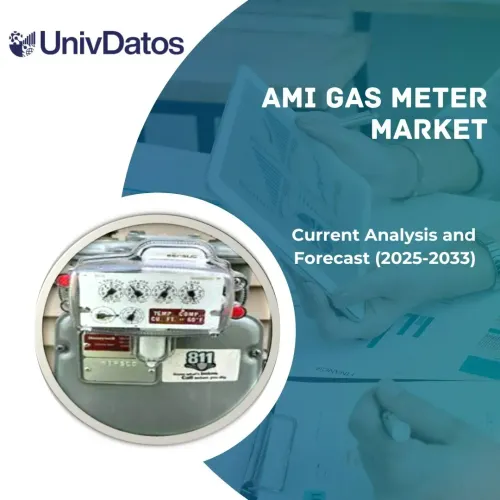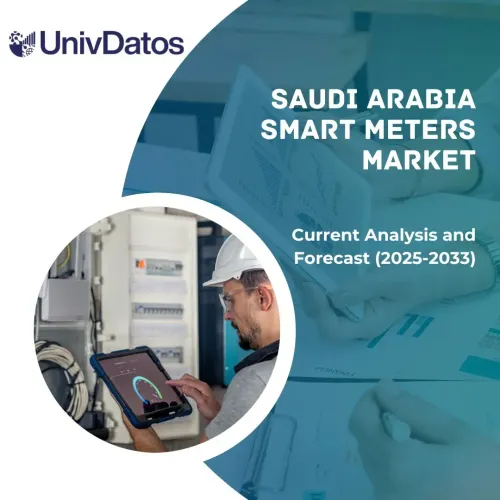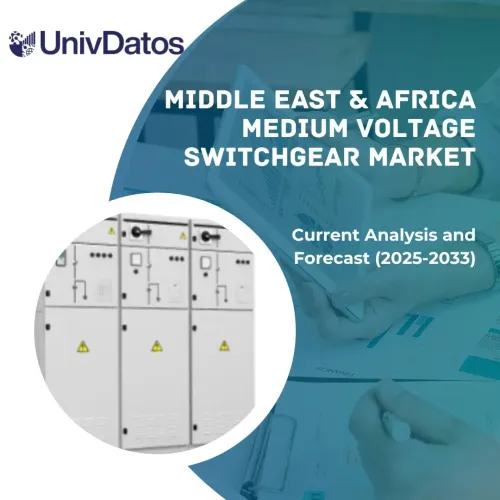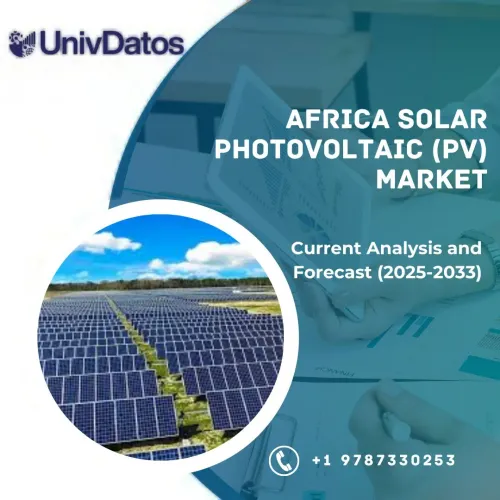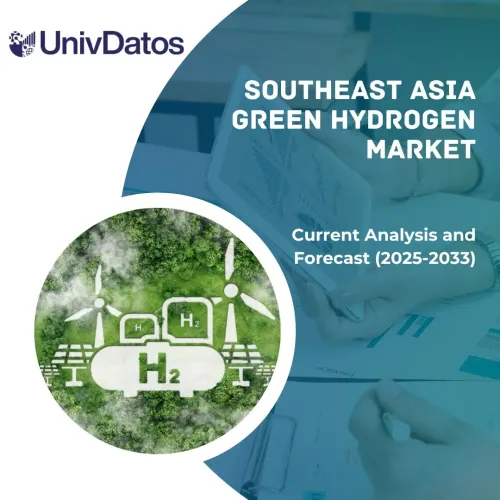- Home
- About Us
- Industry
- Services
- Reading
- Contact Us
String PV Inverter Market: Current Analysis and Forecast (2025-2033)
Emphasis on Power Rating (Up to 10 KW, 10 to 80 KW, and Above 80 KW); Phase (Single and Three); By Application ( Residential, Commercial and Industrial, Utilities); and Region/Country
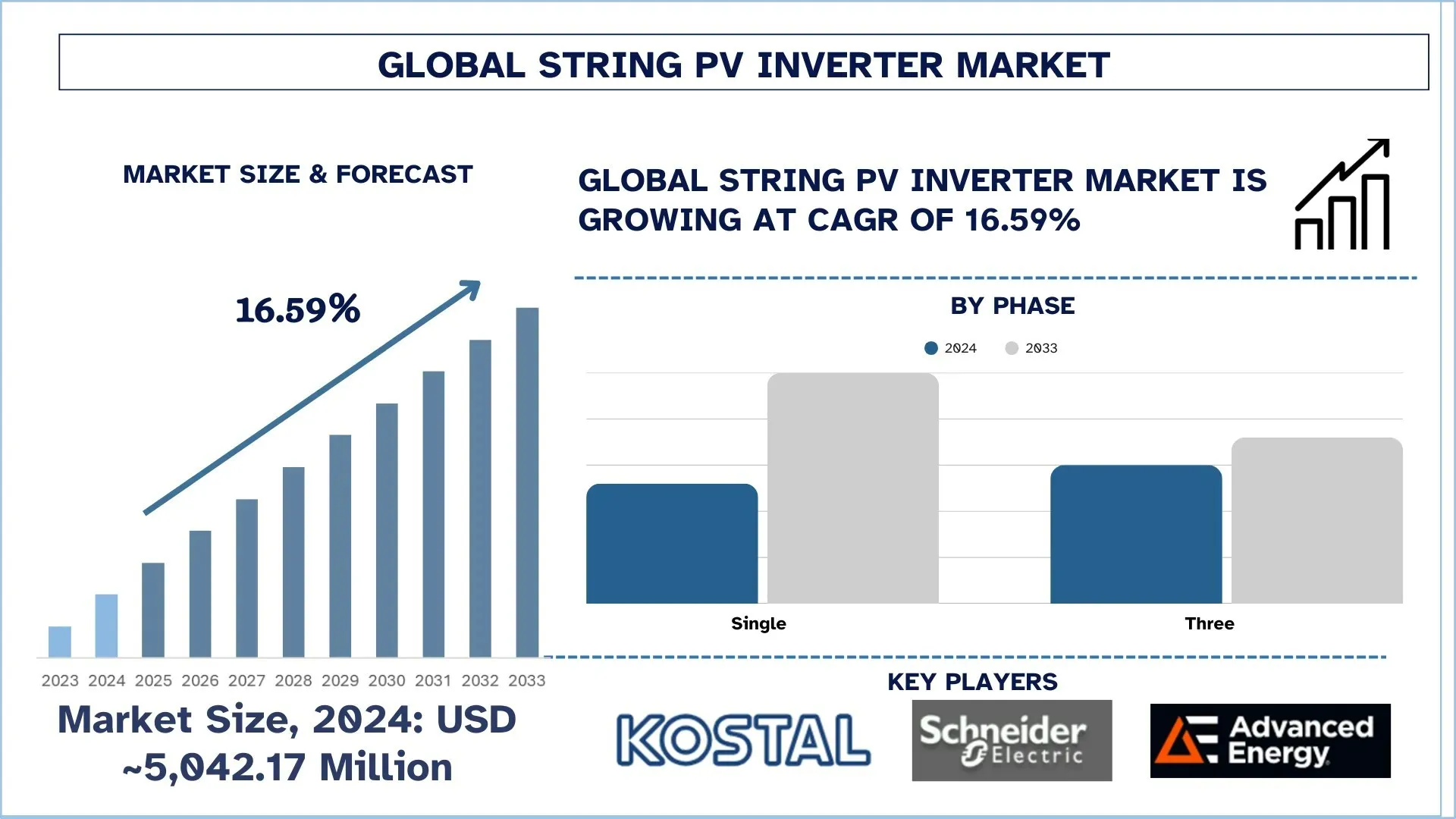
Global String PV Inverter Market Size & Forecast
The global String PV Inverter market was valued at USD 5,042.17 Million in 2024 and is expected to grow to a strong CAGR of around 16.59% during the forecast period (2025-2033F) owing to number of solar power plants as well as burgeoning government support promulgating the installation of new string inverters and demand from the aftermarket.
String PV Inverter Market Analysis
The global String PV Inverter market is driven by the rising demand for inverters with energy-efficient, reliable sources, coupled with the global acceptance of solar energy. String PV inverters convert direct current (DC) energy from solar panels into alternating current (AC), which can be further used in various applications. As the prices of solar panels continue to drop, solar energy becomes affordable, while demand for high-quality string PV inverters increases. Technological advances in inverter efficiency, smart grids, and monitoring systems are serving as catalysts to market growth. Likewise, governmental environmental regulations for clean energy, as well as the general trend towards sustainable energy solutions, have fueled the development of the global string photovoltaic (PV) inverter market.
Global String PV Inverter Market Trends
This section discusses the key market trends that are influencing the various segments of the global String PV Inverter market, as found by our team of research experts.
Increasing Demand for Continuous and Reliable Power Source:
One of the key facets that are contributing to the growth of the global string PV inverter market is an upsurge in the demand for constant and reliable power. At the same time, as the customers, as well as the enterprises, look for increased steadiness and continuity in electricity, the demand for these advanced energy initiatives equipped with proven technologies that guarantee a steady current flow has become stronger. In fact, solar energy technologies, in conjunction with string PV inverters, can be relied upon to convert sunlight into grid-compatible, dependable electric power.
These also provide solar power to regions that have been encouraged to adopt solar as their primary form of energy generation. In places where there is a lack or a completely missing electric infrastructure, solar power, among other energy sources, will provide a major requirement. Using string PV inverters will allow solar installations to provide energy to such areas more efficiently when coupled with energy storage systems, as they could supply power through the day and at night, even during unproductive cloudy periods. This will, nowadays, be witnessed mostly in the sector of commercial and industrial enterprises, where costs of downtime are great and, hence, a stable supply is of top priority considerations.
String PV Inverter Industry Segmentation
This section provides an analysis of the key trends in each segment of the global String PV Inverter market report, along with forecasts at the global, regional, and country levels for 2025-2033.
10-80 KW Category has shown promising growth in the String PV Inverter Market.
The global string PV inverter market, based on power rating, has been segmented into three main categories: Up to 10 KW, 10 to 80 KW, and above 80 KW. Up to 10 KW falls under residential applications, wherein smaller installations are more frequent. The 10 to 80 KW range targets small to medium commercial applications, whereas above 80 KW caters to large-scale industrial and utility-scale installations. Among all the segmentations, 10 to 80 KW has held a notable market share, as commercial solar installation growth has been booming in this range for efficiency vis-a-vis cost. Further, distributed generation systems deploying inverters with high balancing capabilities to meet the diverse energy needs of small businesses and commercial enterprises are additional beneficiaries for this segment. Cost-effectiveness, scalable applicability, and approved reliability attributes provide important market leads to this power range inverter.
Three-Phase Category Dominates the String PV Inverter Market.
Based on phase, the market is bifurcated into single and three. On this record, three-phase inverters have distinguished themselves with an impressive percentage in the market; they are active in high-capacity applications and efficiency-forcing applications of commercial, industrial, or utility-scale installations. These inverters can manage very large energy loads, with consequent better stability and reduced power fluctuation, possible and vital features in large-scale solar systems-and subsequently offer improved energy conversion and system optimization efficiency.
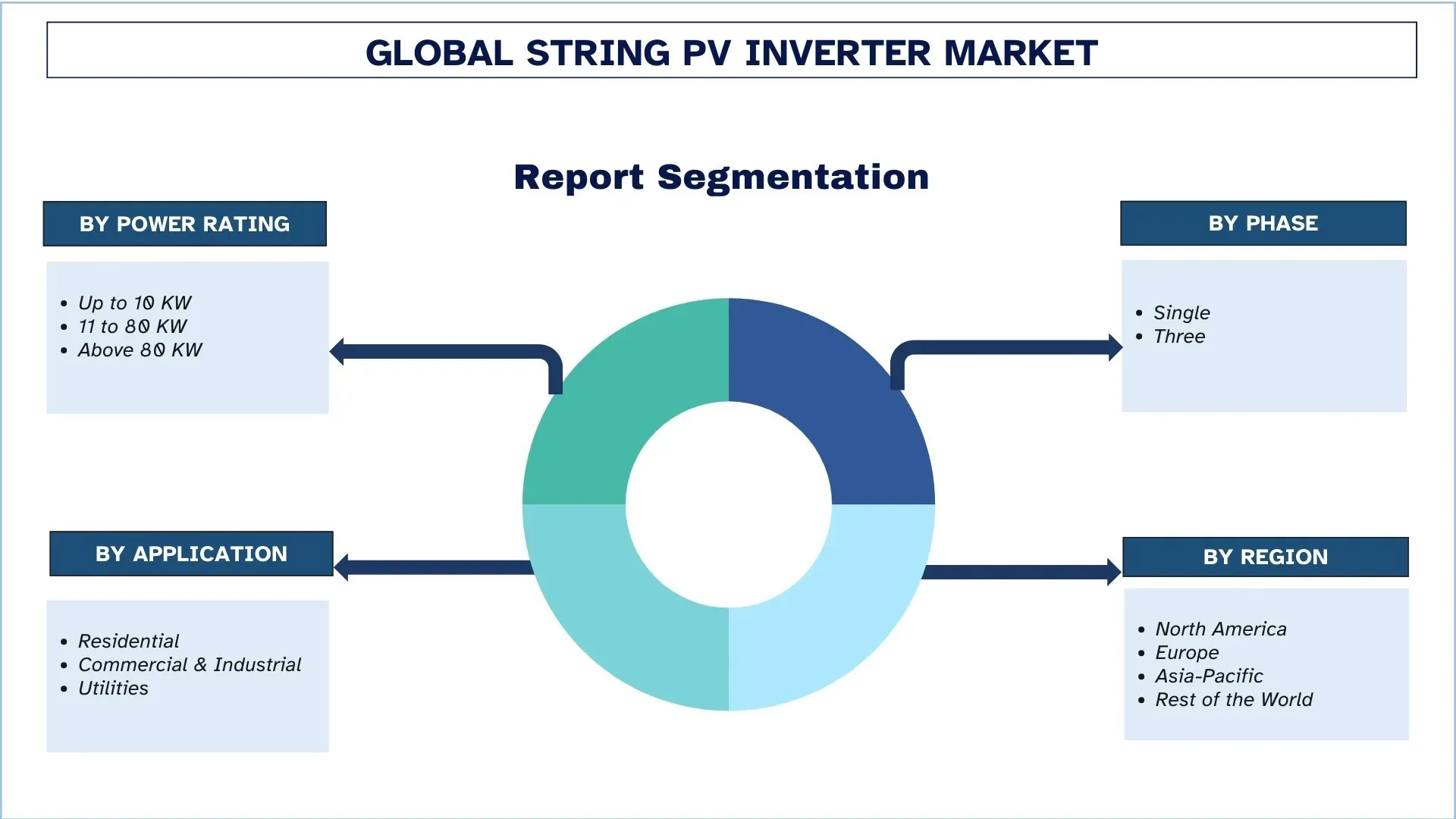
Asia-Pacific is expected to grow at a considerable rate during the forecast period.
The Asia-Pacific (APAC) string photovoltaic (PV) inverter market has held a significant market share due to the rapid uptake of solar energy projects across major countries. The region receives a large amount of sunlight suitable for solar projects, along with the government incentives and supportive policies aimed at curbing carbon emissions and encouraging renewable energy, all of which have propelled the demand for solar power systems, further fueling the demand for the string inverters.
China, being the largest solar market in the world, has a considerable share of the APAC string PV inverter market. The country is certainly a major producer of solar panels and is also at the forefront in the installation of solar energy. Similarly, India has kicked off a lot of solar energy projects, owing to its ambitious renewable energy targets, driving a huge demand for efficient PV inverters.
Technological advances made in string inverters, such as sophisticated communication and monitoring systems, AI-based optimization, improved efficiency, etc., are fueling market growth. Further, their price reductions keep solar panels and inverters accessible to the general public in the APAC region.
The Asia-Pacific market is expected to maintain its continued rapid expansion, with investments in the solar energy infrastructure that will assist in both sustainability goals and energy needs, making this region a key hub for the global PV inverter market.
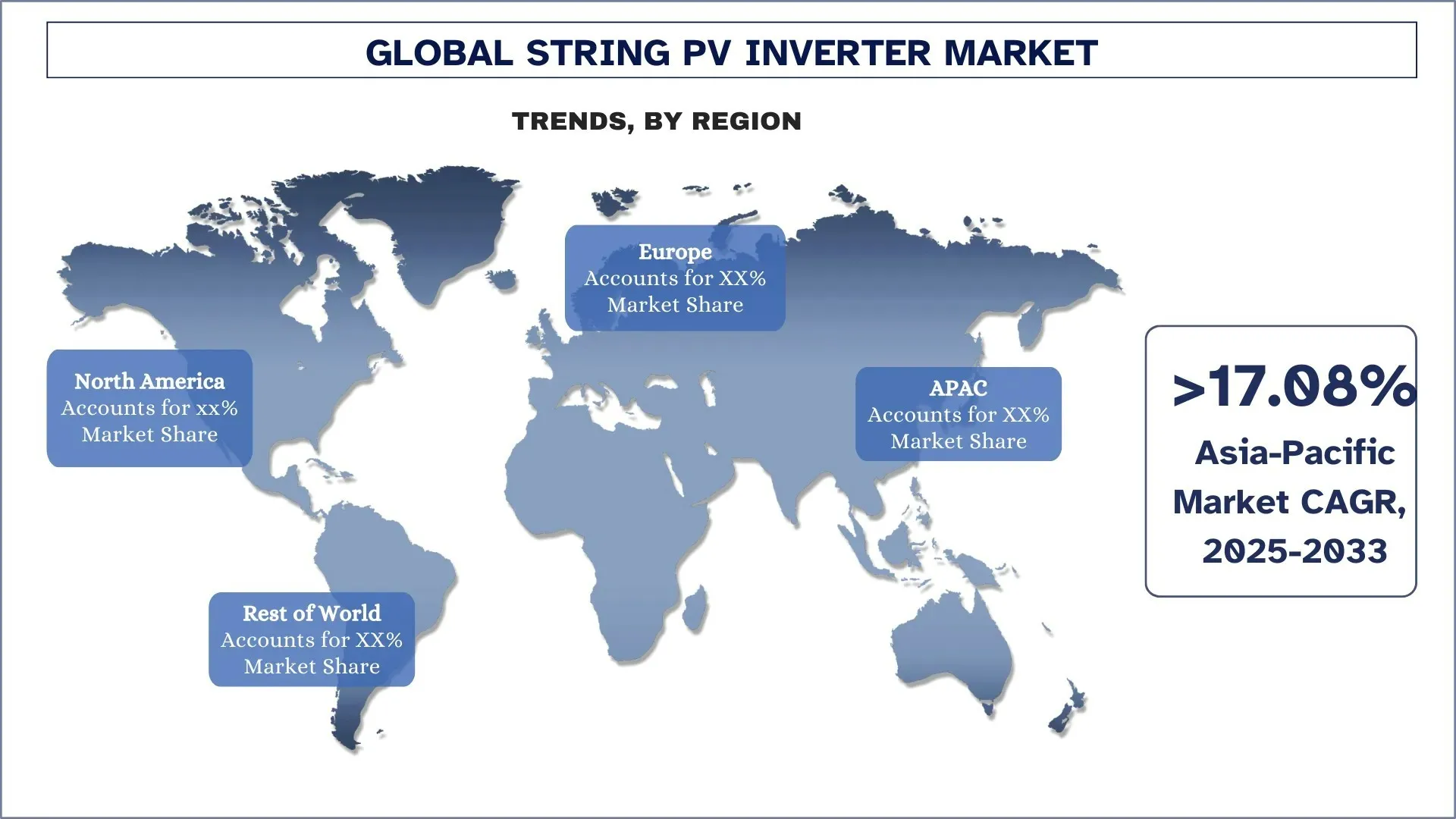
China held a dominant share of the Asia-Pacific String PV Inverter market in 2024
The Chinese string photovoltaic (PV) inverter market takes up the lion's share of the solar energy world as a consequence of the comprehensive development of photovoltaic cell production and installation by the country. China now has an established position as the world's largest producer and consumer of solar energy, into which string inverters fit well.
Therefore, the heights of the demand for string inverters have reached quite a high position, supplemented by solid support from government renewable energy policies in the form of extensive incentives, subsidies, and policies that commensurately lower carbon emissions and drive successively doubles and treble boosts in the adoption of solar power systems throughout the country.
String PV Inverter Competitive Landscape
The global String PV Inverter market is competitive, with several global and international market players. The key players are adopting different growth strategies to enhance their market presence, such as partnerships, agreements, collaborations, new product launches, geographical expansions, and mergers and acquisitions.
Top String PV Inverter Companies
Some of the major players in the market are SolarMax.pk, Huawei Technologies Co. Ltd., Sungrow Power Supply, Fronius International, KOSTAL Solar Electric, Growatt New Energy, Schneider Electric, Ingeteam, Advanced Energy, and KACO New Energy.
Recent Developments in the String PV Inverter Market
- In 2025, CPS America, a Texas-based solar power equipment company, announced the launch of its new line of string inverters with 125-kW/261-kWh C&I BESS All-in-One solution, 250-kW 600-V string inverter, 350-kW string inverter, and 5-MWh BESS PowerBlock.
- In 2025, Sungrow announced to launch its next-generation string inverters in the MENA region. The new product launch is in line with the company’s motive to expand its market share in the MENA region.
- In 2024, Solis unveiled its new range of string inverters with the capacity of 60 KW, 125 KW, and 1500 KW. This product range is in line with the company’s focus to cater to the solar rooftop projects in the U.S. and Canada.
Global String PV Inverter Market Report Coverage
Details | |
Base year | 2024 |
Forecast period | 2025-2033 |
Growth momentum | Accelerate at a CAGR of 16.59% |
Market size 2024 | USD 5,042.17 Million |
Regional analysis | North America, Europe, APAC, Rest of the World |
Major contributing region | Asia-Pacific is expected to dominate the market during the forecast period. |
Key countries covered | U.S., Canada, Germany, U.K., Spain, Italy, France, China, Japan, and India |
Companies profiled | SolarMax.pk, Huawei Technologies Co. Ltd., Sungrow Power Supply, Fronius International, KOSTAL Solar Electric, Growatt New Energy, Schneider Electric, Ingeteam, Advanced Energy, and KACO New Energy |
Report Scope | Market Trends, Drivers, and Restraints; Revenue Estimation and Forecast; Segmentation Analysis; Demand and Supply Side Analysis; Competitive Landscape; Company Profiling |
Segments Covered | By Power Rating, By Phase, By Application; By Region/Country |
Reasons to Buy String PV Inverter Market Report:
- The study includes market sizing and forecasting analysis confirmed by authenticated key industry experts.
- The report briefly reviews overall industry performance at a glance.
- The report covers an in-depth analysis of prominent industry peers, primarily focusing on key business financials, type portfolios, expansion strategies, and recent developments.
- Detailed examination of drivers, restraints, key trends, and opportunities prevailing in the industry.
- The study comprehensively covers the market across different segments.
- Deep dive regional level analysis of the industry.
Customization Options:
The global String PV Inverter market can further be customized as per the requirements or any other market segment. Besides this, UnivDatos understands that you may have your own business needs, hence feel free to contact us to get a report that completely suits your requirements.
Table of Content
Research Methodology for the Global String PV Inverter Market Analysis (2023-2033)
We analyzed the historical market, estimated the current market, and forecasted the future market of the global String PV Inverter market to assess its application in major regions worldwide. We conducted exhaustive secondary research to gather historical market data and estimate the current market size. To validate these insights, we carefully reviewed numerous findings and assumptions. Additionally, we conducted in-depth primary interviews with industry experts across the String PV Inverter value chain. After validating market figures through these interviews, we used both top-down and bottom-up approaches to forecast the overall market size. We then employed market breakdown and data triangulation methods to estimate and analyze the market size of industry segments and sub-segments.
Market Engineering
We employed the data triangulation technique to finalize the overall market estimation and derive precise statistical numbers for each segment and sub-segment of the global String PV Inverter market. We split the data into several segments and sub-segments by analyzing various parameters and trends, by Power Rating, By Phase, By Application, and by Regions within the global String PV Inverter market.
The Main Objective of the Global String PV Inverter Market Study
The study identifies current and future trends in the global String PV Inverter market, providing strategic insights for investors. It highlights regional market attractiveness, enabling industry participants to tap into untapped markets and gain a first-mover advantage. Other quantitative goals of the studies include:
- Market Size Analysis: Assess the current and forecast market size of the global String PV Inverter market and its segments in terms of value (USD).
- String PV Inverter Market Segmentation: Segments in the study include areas by Power Rating, By Phase, By Application, and region.
- Regulatory Framework & Value Chain Analysis: Examine the regulatory framework, value chain, customer behavior, and competitive landscape of the String PV Inverter industry.
- Regional Analysis: Conduct a detailed regional analysis for key areas such as Asia Pacific, Europe, North America, and the Rest of the World.
- Company Profiles & Growth Strategies: Company profiles of the String PV Inverter market and the growth strategies adopted by the market players to sustain in the fast-growing market.
Frequently Asked Questions FAQs
Q1: What is the global String PV Inverter market’s current market size and growth potential?
The global String PV Inverter market was valued at USD 5,042.17 million in 2024 and is expected to grow at a CAGR of 16.59% during the forecast period (2025-2033).
Q2: Which segment has the largest share of the global String PV Inverter market by phase?
The three-phase segment led the market in 2024. Due to the high-capacity applications and efficiency-forcing applications of commercial, industrial, or utility-scale installations, the segment has held a sizable market share.
Q3: What are the driving factors for the growth of the global String PV Inverter market?
Conducive Government Policies: Government support plays a significant role in accelerating the growth of the global String PV Inverter market. Many countries are implementing favorable policies, such as subsidies, tax incentives, and renewable energy targets, to promote the use of solar energy. These supportive regulatory frameworks help drive demand for solar power systems and, consequently, the need for efficient string inverters. By encouraging the shift towards renewable energy and providing financial incentives, governments contribute to the rapid adoption of string PV inverters, enhancing market expansion.
Rise of Solar Power Across the Globe: As the global demand for clean and sustainable energy grows, the adoption of solar power continues to increase. This shift toward solar energy is a significant driver for the string PV inverter market. With solar power becoming a preferred choice for residential, commercial, and industrial applications, the need for reliable and efficient string inverters to optimize energy production is on the rise. As more regions turn to solar as a primary energy source, the demand for advanced inverters that ensure higher efficiency and better performance continues to grow.
Declining Cost of Solar Panels: The declining cost of solar panels has had a profound impact on the global string PV inverter market. Technological advancements and economies of scale have reduced the cost of manufacturing solar panels, making solar energy more affordable and accessible. As the price of solar panels continues to decrease, the overall cost of solar installations is becoming more competitive, encouraging widespread adoption.
Q4: What are the emerging technologies and trends in the global String PV Inverter market?
Increasing Demand for Continuous and Reliable Power Source: As the need for stable and uninterrupted energy grows, there is an increasing demand for solar power solutions that offer consistent and reliable electricity. String PV inverters are becoming essential in ensuring that solar energy systems deliver continuous power, especially in regions with unreliable grid infrastructure or during peak demand times. These inverters help maintain energy flow, mitigate downtime, and enable power supply even in areas with limited access to traditional energy sources. This trend is particularly relevant in sectors like industrial and commercial applications, where energy stability is crucial to operations.
Integration of Smart Technologies: The integration of smart technologies into string PV inverters is revolutionizing the market. Advanced features such as artificial intelligence (AI), machine learning (ML), and the Internet of Things (IoT) are enhancing the performance and optimization of solar energy systems. These technologies enable real-time monitoring, predictive maintenance, and dynamic adjustments to energy output based on weather conditions, grid demands, and user consumption patterns.
Q5: What are the key challenges in the global String PV Inverter market?
High Initial Cost: The high initial investment required for string PV inverters, along with other solar components, remains a key challenge. Despite long-term cost savings, the upfront expenses can be a barrier for residential, commercial, and industrial sectors, particularly in emerging markets where budget constraints hinder widespread adoption.
Technical Complexity and Compatibility: String PV inverters often involve technical complexities, especially when integrating with existing energy systems. Ensuring compatibility between inverters, solar panels, and energy storage systems requires careful consideration and expertise. This complexity can discourage potential customers from adopting solar energy solutions and limit market growth, especially in regions with limited technical support.
Q6: Which region dominates the global String PV Inverter market?
Asia-Pacific holds the largest market share due to the higher investment in solar power projects by the leading countries as China, India, Japan, etc. Additionally, the regions with its focus on public-private partnership for the development of renewable energy projects are further anticipated to lead the market growth.
Q7: Who are the key players in the global String PV Inverter market?
Some of the major companies in String PV Inverter include:
SolarMax.pk
Huawei Technologies Co. Ltd.
Sungrow Power Supply
Fronius International
KOSTAL Solar Electric
Growatt New Energy
Schneider Electric
Ingeteam
Advanced Energy
KACO New Energy
Q8: How are technological advancements shaping the future of String PV Inverter?
Technological advancements such as AI integration, machine learning algorithms, and IoT connectivity are significantly improving the efficiency and performance of String PV inverters. These innovations allow for real-time monitoring and dynamic adjustments based on weather conditions, energy consumption patterns, and grid demands.
Q9: What regulatory challenges are impacting the global String PV Inverter market?
The String PV Inverter market faces regulatory challenges such as varying standards and certifications across regions, complicating global market access. Inconsistent grid integration requirements and certification processes add complexity to product development and market entry. Additionally, the uncertainty or fluctuation in financial incentives and subsidies for solar energy systems can affect consumer adoption and investment in string inverters, hindering market growth.
Related Reports
Customers who bought this item also bought

